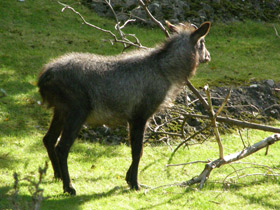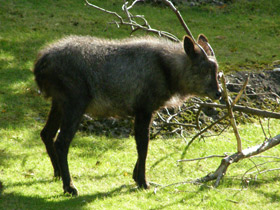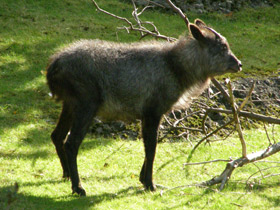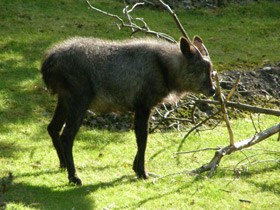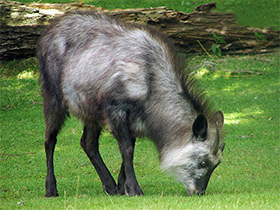The Japanese serow Capricornis crispus
The Japanese serow is endemic to Japan where it is found on three of the main islands: Honshu, Shikoku and Kyushu, although in the past it occurred in all mountain areas of Japan. The Japanese serow’s appearance resembles that of the gray goral and some scientists even relate these two species in the same genus. The Japanese serow is a small bovid that weighs only 35 to 38 kg and stands at up to 90 cm at the shoulders, with females being slightly smaller than males. The colour of their dense, chunky coat may vary from black-grey to reddish-brown, with almost white undersides and white patches on the legs, neck, and face. Both males and females bear short curved horns (males’ horns are 10 cm long and 3 cm thick at the base, while females’ horns have a length of 4 to 6 cm). It is interesting that the number of the transverse rings on the serow’s horn may serve an indicator of the animal’s age. Japanese serows are solitary animals. Their diet includes leaves of thuja and Japanese cypress, as well as fallen acorns. They form monogamous pairs only in the mating season which lasts from September through November, and gather in small groups in winter time. Serows are active in the early morning and late afternoon, resting in the tree shade during the rest of the day. These animals are mainly found close to the upper edges of the forests and near bush thickets and rocky outcrops. One calf, rarely twins, is born in a shelter. Young serows reach sexual maturity at the age of 2.5 years. The longevity of these animals in captivity is 10 to 12 years. Predators and diseases dramatically reduce their life span in the wild – the longevity of wild serows is typically less than 5 years. Due to severe decline in the early 20th century, serow was designated a ‘Non Game Species’ by the Hunting Law of 1925 and hunting of this species was prohibited. In 1934, this species was designated to ‘’Natural Monument Species’’ under the Law for Protection of Cultural Properties. Currently the population is assumed to be stable or slowly increasing.

















